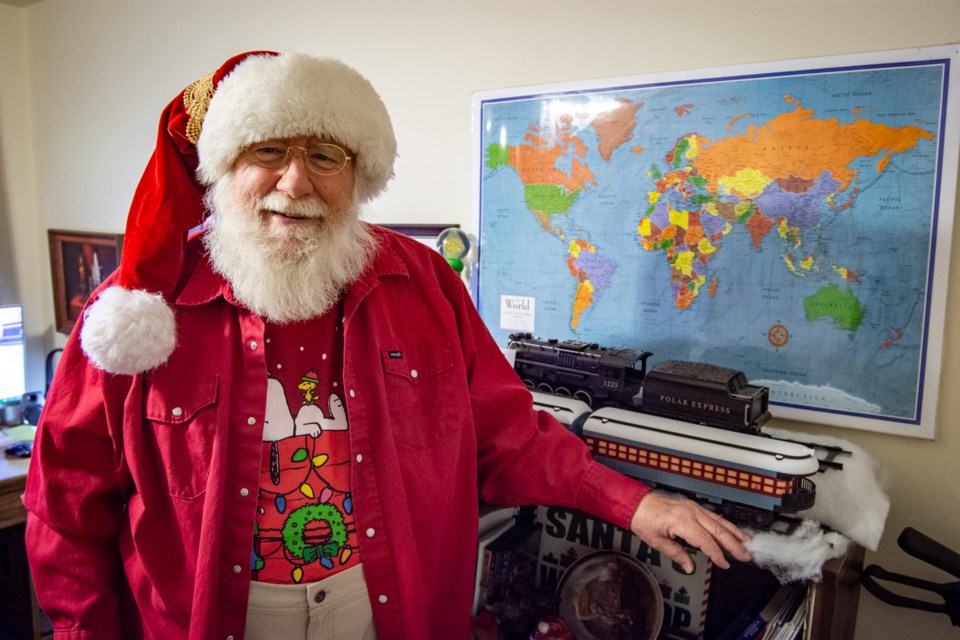Editor’s note: This story was originally published by CPR News and was shared via AP StoryShare.
On a recent December evening, a white-bearded man wearing a red button-down shirt and a big red hat with a fluffy, white pom-pom on the end sat at his desk in Longmont. Santa was at work, ready to listen to the wish lists of Christmas lovers. Soon, Natalie from Oklahoma City was patched in via ham radio. The 11-year-old said she wants a hair straightener for Christmas this year, and Santa promised to bring her a surprise on Christmas Eve. But, he said, “you just have to be sound asleep — and no traps!”
John Chilson bought his first Santa Claus suit 22 years ago, after his mother passed away. She loved the color red, and when he stumbled on the costume at a Wal-mart, he thought of her and bought it on a whim. While the suit was first a hobby, it eventually became a profession and identity (Chilson prefers to go by Santa).
Last year, Santa couldn’t do any events in person because of the pandemic, so he went looking for other ways to connect with kids. He began setting up video chats via Zoom for a fee. And when the Longmont Amateur Radio Club, or LARC, invited him into the world of ham radio, he embraced the opportunity.
“I’m just enough of a geek that I can pull it off,“ he said.
Ham radio is similar to citizens band, or CB, radio, but you need a license from the FCC in order to operate one. Because ham radio is regulated, you won’t hear cursing, political talk or commercial content over those parts of the radio frequency spectrum.
The idea of connecting Santa to children over ham radio was the brainchild of members of LARC, who introduced him to Chuck Poch, LARC’s board president.
Poch only adopted the hobby about five years ago, he became enamored with the technology. He is now licensed and has his own call sign — K0ITP — to connect with other ham radio operators.
“I started playing with it and found that there’s all kinds of facets with ham radio,” he said. “You learn something new every day, from building antennes to building your own radios. There’s a lot of science involved.”
Poch said there are millions of ham radio operators worldwide and more than 20,000 licenses issued in Colorado. For him, it’s a way for people to connect using technology that’s been around for more than 100 years. While many people use ham radio for fun, the technology can be lifesaving in the event of an emergency.
“Usually in a disaster-type scenario, when you’ve lost power — cell phone, internet, all forms of communication — most emergency agencies are going to go look for a ham radio operator to make contact,” he said.
That was true in Colorado during the 2013 floods that hit Boulder County particularly hard, Poch added.
Despite its utility, ham radio’s popularity is dwindling because cell phones and the internet have made it easier to communicate. So Poch and the LARC have been looking for ways to introduce more young people to the hobby. When the pandemic interrupted in-person gatherings last year, the club came up with the idea to connect kids to Santa over the airwaves.
The experiment worked. And earlier this month, Santa did another round of ham radio visits every night for nearly a week.
Poch — who goes by Chuckie the Airwaves Elf — served as the control operator, moderating the communication and making sure everyone followed FCC rules. At the beginning of one session, he called into his radio transceiver: “Good evening, looking for boys and girls from around the world, Longmont, or wherever you’re from to talk to Santa Claus this evening.”
In order to participate, the kids need to know someone with a ham radio and a license to operate it — usually a parent, grandparent or neighbor. Many of the families find out about this through Facebook or word of mouth. Kids have radioed in from across the Front Range, from states like Ohio, and as far away as Canada.
Though Santa uses computer software called EchoLink that patches him into the ham radio signals, he still has a call sign: N0P, which stands for The North Pole. When he runs into technical problems, he chalks the bad connection up to interference from sunspots and the Northern Lights near his home in The North Pole.
But, he says the technical hoops are worth jumping through in order to talk to families he might not otherwise reach. Especially at a time when there’s a Santa shortage.
“Last year was so traumatic for so many people,” he said. “They needed somebody like Santa to talk to and to encourage them; to bring them some hope and joy. And that's something I seem to be good at.”
Throughout that night in December, Santa shared jokes and stories about Mrs. Claus and the reindeer. And with Natalie from Oklahoma City on the ham radio, he asked if she had ever heard someone say Santa isn’t real.
“Yes I have. But I really don’t believe it,” she said.
“Well Natalie, I’m glad you don’t believe it,” he said. “But let me tell you what the most important thing is: that you remember Santa Claus believes in you. And I do. You’re a delightful person, and just keep on being kind to everybody.”
Pedro Lumbrano contributed to this story.



